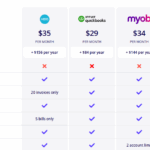 We’re publishing a series of posts about financial planning for small business and in our most recent post about ongoing capital purchases and running costs we mentioned creating a financial spreadsheet to track all of your expenses, which we’re going to talk about in a little more detail in this post.
We’re publishing a series of posts about financial planning for small business and in our most recent post about ongoing capital purchases and running costs we mentioned creating a financial spreadsheet to track all of your expenses, which we’re going to talk about in a little more detail in this post.
History of the Spreadsheet
A spreadsheet may now be intrinsically linked to Excel, but its history is much longer than Microsoft’s. The word ‘spreadsheet’ came from the term ‘spread’ which referred to a newspaper or magazine item that covered two facing pages, while ‘spreadsheet’ as a compound came to mean the format used to present bookkeeping ledgers, which were traditionally ‘spread’ across two sheets of paper, or one oversized sheet of paper.
Professional planners have long used spreadsheets as a way to guess the future, by setting up parameters – using a formula – that answers a question. For example, you could use a financial spreadsheet to determine how much money you have to spend on staff. By imputing your current expenses and income, you would be able to see how much revenue you would need to generate before you could hire an employee.
Excel, of course, handles this very easily and very well. You can also create multiple spreadsheets that are linked, allowing the figures in one spreadsheet to be transferred to another easily.
What to List in Your Start-Up Spreadsheet
In your start-up spreadsheet, you need to list all of your depreciable and non-depreciable costs as well as the capital items you intend on purchasing within the first year of business. Once you have listed all of your initial expenses in your start-up spreadsheet, you’ll now need to identify your potential income streams (also known as sales forecasting), which you should separate into categories – this will also help you finalise your marketing plan.
Your Sales Forecast
In your sales forecast, you are identifying how many products/services you are going to sell, whereas in your marketing plan you are outlining how you will achieve that. It’s this intimate relationship between a financial plan and marketing plan that makes financial planning such an important undertaking for every business, large or small.
The most important thing to remember here is that your sales forecast should be answering a question. That question may change over time, or you may have multiple questions you want answers to – in which case, you would also have multiple spreadsheets, which is where linking them together comes into play.
When you start out, you’ll most probably want to know how much products/services you need to sell before you start turning a profit, but as your business becomes more established, the question may soon become: “How many sales are generated from our website?” or “How many sales do I need before I can employee a staff member?”
Having determined your income streams, you will need to establish a standard price for your products or services. If you’re likely to have a spread of profit ranges, you may want to apply the cost/sale price ratio to all items. You may want to work out a best case/worst case scenario here, and perhaps select a middle ground.
Once you’ve determined each income stream and the costs, you’ll need to enter the number of units or the hours that you think will be sold each month. The next step is to calculate the ‘total sales’ as well as the ‘total cost of sales’ on a monthly basis. The next thing you now need to look at is your cash flow, which is an essential component for any successful business. We will take a look at this in much greater detail in our next post, but for now, if you would like more information on financial planning, you can read some older posts in the financial planning series.
Alternatively, our Small Business Management course takes students through every step in the process of starting and managing a small business, including financial planning. For more information, visit our website or contact our team.



















